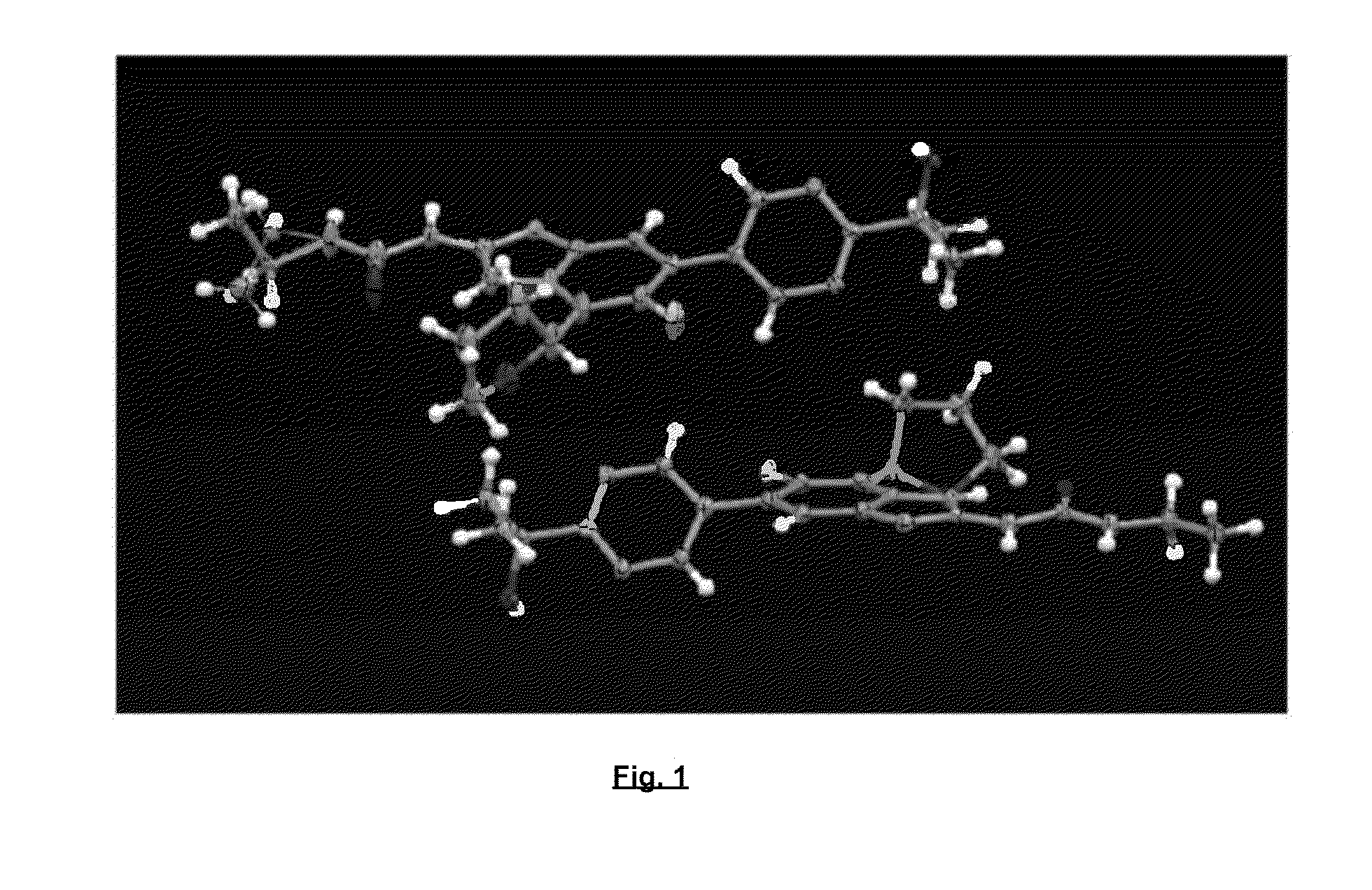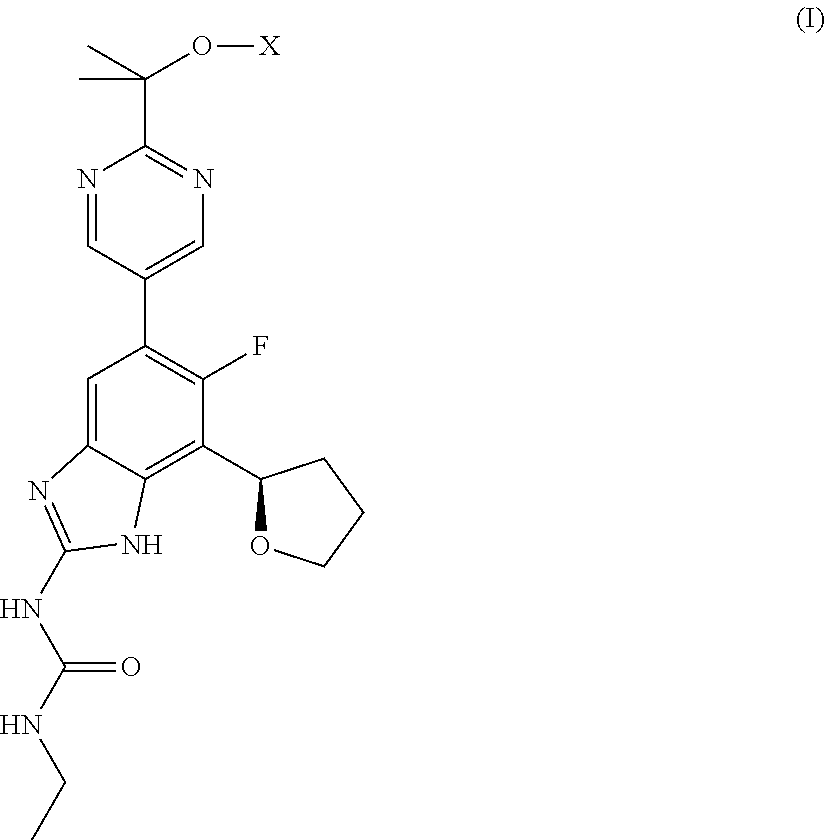Phosphate esters of gyrase and topoisomerase inhibitors
a technology of phosphate esters and gyrase, which is applied in the direction of antibacterial agents, drug compositions, biocides, etc., can solve the problems of bacterial infections that are difficult to treat with antibiotics or even untreatable, and the problem of bacterial infection has become particularly serious, so as to control, treat or reduce the severity or effect of bacterial infection in a patient, and control, treat or reduce the progress of bacterial infection
- Summary
- Abstract
- Description
- Claims
- Application Information
AI Technical Summary
Benefits of technology
Problems solved by technology
Method used
Image
Examples
preparation 1
Preparation of 2-(2-fluoro-6-nitro-phenyl)-2,3-dihydrofuran (15A) and 2-(2-fluoro-6-nitro-phenyl)-2,5-dihydrofuran (15B)
[0258]
[0259]2-Bromo-1-fluoro-3-nitro-benzene (14) (200.3 g, 98%, 892.3 mmol, Bosche F6657), 1,4-dioxane (981.5 mL, Sigma-Aldrich 360481), and 2,3-dihydrofuran (2) (341.1 mL, 99%, 4.462 mol, Aldrich 200018) were charged in a reaction flask, followed by N,N-diisopropylethylamine (155.4 mL, 892.3 mmol, Sigma-Aldrich 550043) and bromo(tri-tert-butylphosphine)palladium(I) dimer (6.936 g, 8.923 mmol, Johnson Matthey C4099). The mixture was stirred at reflux for 2 hrs (HPLC showed 98% consumption of starting arylbromide). It was allowed to cool, the precipitate was removed by filtration, rinsed with EtOAc, and the filtrate concentrated in vacuo to a dark reddish brown semi-solid oil. This was dissolved in CH2Cl2, eluted through a plug of silica with CH2Cl2, and concentrated in vacuo giving a mixture of 15A and 15B as a dark amber oil (291.3 g). The crude product was carri...
preparation 2
Preparation of 3-fluoro-2-tetrahydrofuran-2-yl-aniline (16)
[0260]
[0261]Placed 5% palladium on carbon (37.3 g, 50% wet, 8.76 mmol, Aldrich 330116) in a Parr bottle under nitrogen, followed by MeOH (70 mL, JT-Baker 909333). Added the crude mixture of 2-(2-fluoro-6-nitro-phenyl)-2,3-dihydrofuran and 2-(2-fluoro-6-nitro-phenyl)-2,5-dihydrofuran (15A&15B) (186.6 g, 892.1 mmol) dissolved in MeOH (117 mL), followed by NEt3 (124.3 mL, 892.1 mmol, Sigma-Aldrich 471283). Placed the vessel on a Parr shaker and saturated with H2. After adding 45 psi H2, the reaction mixture was shaken until consumption of the starting material was complete (HPLC and LCMS showed complete reaction). The reaction mixture was purged with nitrogen, filtered through Celite™ and rinsed with EtOAc. The filtrate was concentrated on a rotary evaporator giving a brown oil, which was dissolved in Et2O and washed with water (2×). The ether phase was extracted with aqueous 1N HCl (5×250 mL), which was washed with Et2O (3×) a...
preparation 3
Preparation of 4-bromo-3-fluoro-2-tetrahydrofuran-2-yl-aniline (17)
[0262]
[0263]To a stirring solution of 3-fluoro-2-tetrahydrofuran-2-yl-aniline (16) (131.9 g, 92%, 669.7 mmol) in methyl tert-butyl ether (1.456 L) and acetonitrile (485 mL) cooled to −20° C. was added N-bromosuccinimide (120.4 g, 99%, 669.7 mmol, Aldrich B81255) in 3 portions maintaining a reaction temperature below about −15° C. After complete addition stirring was continued at −15 to −10° C. for 30 minutes. 1H NMR of a worked-up aliquot showed 96% consumption of starting aniline so added another 4.82 g NBS and stirred at −10° C. for another 30 minutes. Aqueous 1N Na2S2O3 (670 mL) was added to the reaction mixture. The cold bath was removed, the mixture stirred for 20 minutes, then diluted with EtOAc. The layers were separated and the organic phase was washed with saturated aqueous NaHCO3 (2×), water, brine, dried over Na2SO4, decanted, and concentrated under reduced pressure giving a dark amber oil. The residue was...
PUM
| Property | Measurement | Unit |
|---|---|---|
| flow rate | aaaaa | aaaaa |
| temperature | aaaaa | aaaaa |
| temperature | aaaaa | aaaaa |
Abstract
Description
Claims
Application Information
 Login to View More
Login to View More - R&D
- Intellectual Property
- Life Sciences
- Materials
- Tech Scout
- Unparalleled Data Quality
- Higher Quality Content
- 60% Fewer Hallucinations
Browse by: Latest US Patents, China's latest patents, Technical Efficacy Thesaurus, Application Domain, Technology Topic, Popular Technical Reports.
© 2025 PatSnap. All rights reserved.Legal|Privacy policy|Modern Slavery Act Transparency Statement|Sitemap|About US| Contact US: help@patsnap.com



